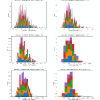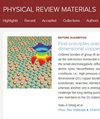高辐射照射下的纳米结晶钨
IF 3.4
3区 材料科学
Q2 MATERIALS SCIENCE, MULTIDISCIPLINARY
引用次数: 0
摘要
在低温高剂量极限下,通过原子尺度模拟研究了纳米晶(NC)钨在辐照下的演变。对至少含有一百万个原子、晶粒尺寸从 5 纳米到 20 纳米不等的样品进行的统计分析表明,NC 材料的微观结构演变模式与单晶体有很大不同。低晶粒尺寸极限的高抗膨胀性源于晶界原子构型的初始过剩体积和晶界缺陷凹陷区的高整体体积的共同作用。晶界通过其局部原子构型的重新排列湮灭缺陷,成为缺陷的波动动态汇。与单晶材料相比,晶粒尺寸分布随剂量的变化而缓慢扩大,从而推迟了辐射驱动的渐近稳定状态的出现。晶粒尺寸和拓扑结构所造成的空间限制阻碍了渗流位错网络的形成,导致即使在高辐照条件下,微结构中也只能保留孤立的位错环。本文章由计算机程序翻译,如有差异,请以英文原文为准。

Nanocrystalline tungsten at high radiation exposure
Evolution of nanocrystalline (NC) tungsten under radiation exposure is investigated by atomic scale simulations in the low temperature high dose limit. Statistical analysis of samples containing at least a million atoms, with grain size varying from 5 nm to 20 nm, shows that the pattern of microstructural evolution of a NC material differs significantly from that of a single crystal. The high resistance to swelling in the low grain size limit stems from a combined effect of the initial excess volume of atomic configurations at grain boundaries and high integral volume of grain boundary defect-denuded zones. Grain boundaries annihilate defects through the rearrangement of their local atomic configurations acting as fluctuating dynamic sinks for defects. Grain size distribution slowly broadens as a function of dose, delaying the onset of an asymptotic radiation-driven steady state in comparison with a single crystalline material. Spatial limitations imposed by the size and topology of grains prevent the formation of a percolating dislocation network, resulting in only isolated dislocation loops being retained in the microstructure even at high radiation exposure.
求助全文
通过发布文献求助,成功后即可免费获取论文全文。
去求助
来源期刊

Physical Review Materials
Physics and Astronomy-Physics and Astronomy (miscellaneous)
CiteScore
5.80
自引率
5.90%
发文量
611
期刊介绍:
Physical Review Materials is a new broad-scope international journal for the multidisciplinary community engaged in research on materials. It is intended to fill a gap in the family of existing Physical Review journals that publish materials research. This field has grown rapidly in recent years and is increasingly being carried out in a way that transcends conventional subject boundaries. The journal was created to provide a common publication and reference source to the expanding community of physicists, materials scientists, chemists, engineers, and researchers in related disciplines that carry out high-quality original research in materials. It will share the same commitment to the high quality expected of all APS publications.
 求助内容:
求助内容: 应助结果提醒方式:
应助结果提醒方式:


